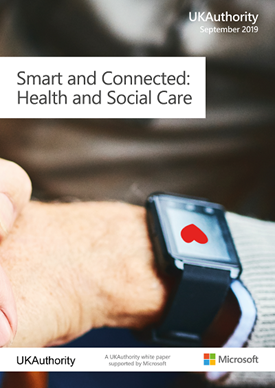Industry voice: a convergence of data provides the basis for a modernised, more strongly integrated approach to health and social care, writes Faith la Grange, director for local and regional government, Microsoft

Health and social care are on the verge of a revolution with the emergence of new technologies in the field.
There is a fantastic potential to develop better integrated, person centred models of care in which health and social care providers work together more effectively, but it is not just about the array of new devices and digital systems. It will only work to its full potential by pulling together the disparate strands of data onto a single platform.
This is reflected in the ambitious vision of the Manchester Local Care Organisation (MLCO) – the recently formed public sector partnership of health and social care bodies in the city council area. MLCO and Manchester City Council are exploring the creation of a digital ecosystem with global players such as Microsoft, plus a range of providers in an exploratory phase, that makes all data from its disparate systems and services available in one place.

The aim is to provide a single view of all the records, strands of care and factors affecting the wellbeing of an individual, and at giving the organisation a clear view of the immediate outlook for providing necessary care throughout the area.
The emergence of this new dimension results from three major factors. One is the explosion of mobile technology in everyday life, with the capacity to give people access to an array of data from devices from almost any location. It provides the scope to provide treatment remotely, through simple advice, assistance with medication or exercises supported by technology.
Secondly, the more recent emergence of internet of things (IoT) sensors and devices is providing the ability to monitor a person’s behaviour and health in their own home, with the capacity for alerts if anything goes wrong and the triggers to support a proactive approach to prevent health problems.
Thirdly, the ongoing development of AI is opening up new possibilities for predicting problems in advance, both for the individual and at a public health level.
Source of problems
The underpinning element in all of these is the data, both on the wellbeing of the individual and the capacity of the whole care system to respond and deal with problems. Traditionally this data has accumulated on disparate, siloed systems that have seldom connected to each other or fed into a central source. This has contributed to the historical disjoint between health and social care and has consistently caused problems within the two sectors.
Now, however, MLCO is aiming to rectify the disjoint through the development of a new data platform.
“We’ve been exploring the conceptual piece, the art of the possible alongside Microsoft and others,” Nicky Parker, director of business change and transformation at Manchester City Council said at a recent exploration event. “It’s about how might we aggregate all the data into one digital platform with a series of dashboards to help drive the command centre.

“Imagine if we could see all the data from across the city system: what’s happening across the city, in our localities and in our 12 integrated neighbourhood teams. What different decisions might we make if we could see everything on one screen in a command centre, or out in the neighbourhoods on a mobile device?”
The ambition would make the platform available to a control centre that enables staff to spot when an individual needs support, pull up the information to understand what form that support or immediate help should take, and assess how best it can be delivered. The key is in using the information to make the right decisions in real-time.
Dashboard view
It also includes the creation of a dashboard on all current activity in the care sector, taking in factors such as available appointments at GP surgeries, waiting times in hospital A&E departments, ambulance activity, the availability of specialists such as district nurses, physiotherapists and crisis response teams, and what they are delivering at a specific time - and where.
It amounts to connecting data around people’s needs to proactively provide better care, working with multiple partners and improving the flow of activity – while at the same time ensuring that the person in need is always at the centre of everything.
There are challenges in making this possible, partly in providing the technical interoperability, and in ensuring that the data can be entered just once to populate the platform for all the appropriate people to see. Then there are demands in preserving the security of the data and ensuring that the right sharing protocols are in place. There is a need for data protection impact assessments and robust consent mechanisms for sharing.
Along with this is the need for organisational and cultural change, with leaders having to get behind the effort and staff from all of the agencies being ready to utilise the data to the full. This will not happen overnight, but an ambitious organisation such as MLCO can take a progressive approach that soon shows positive results.
Coordination benefits
Numerous benefits could be achieved. There is the prospect of a great improvement in the coordination of care, focused on the individual and with a more proactive approach that can keep them out of hospital and in their own home for longer. The growing take-up of assistive technology promises fresh streams of data that can make a big contribution to supporting people safely in their own homes further into old age, reducing the burden on the public sector and improving their quality of life.
It can improve coordination between agencies, reducing the disruptions and inefficiencies that waste resources and ensuring they are better placed to provide the right care at the right time.
It can lead to a more proactive approach to care, supporting early interventions to prevent more people from falling ill and helping them to better manage their own health.
In addition, it can provide the data that feeds into analytics and helps organisations anticipate increases in demand and spot the long term trends. This lays the ground for better strategic planning and investment of resources.
While MLCO is leading the initiative in Manchester there is a great scope for this type of change around the country. The community needs and challenges are similar, and health and care organisations hold the wealth of data that provides the key to a successful response. A data platform can connect the information around people’s needs, so it can be used it to intervene, prevent and provide better care.
Since the exploratory event, MLCO has been in a discovery phase but is now poised to take the next steps to meet the pressures of winter.
Download the 'Smart and Connected - Health and Social Care' white paper exploring the potential of emerging technologies to transform the integration of health and care in adult and children’s services.
For more information on the technology and vision for health and social care, contact Helena Zaum and Ellen Wilson, industry solutions executives at Microsoft
For information on the research, contact the UKAuthority research team.






